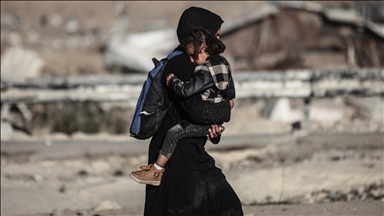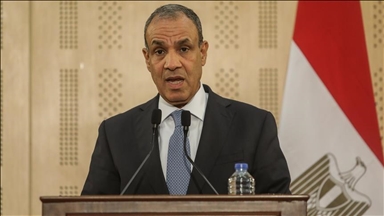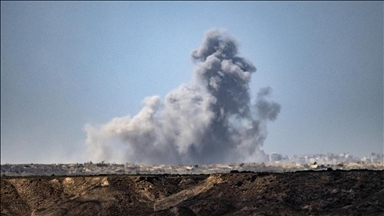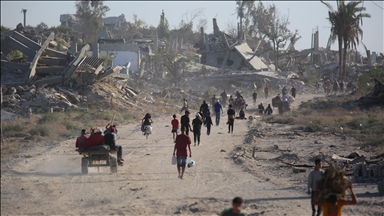What Gaza needs: Billions required for recovery from Israel’s devastation
Experts estimate $50 - $70B needed for reconstruction of Gaza
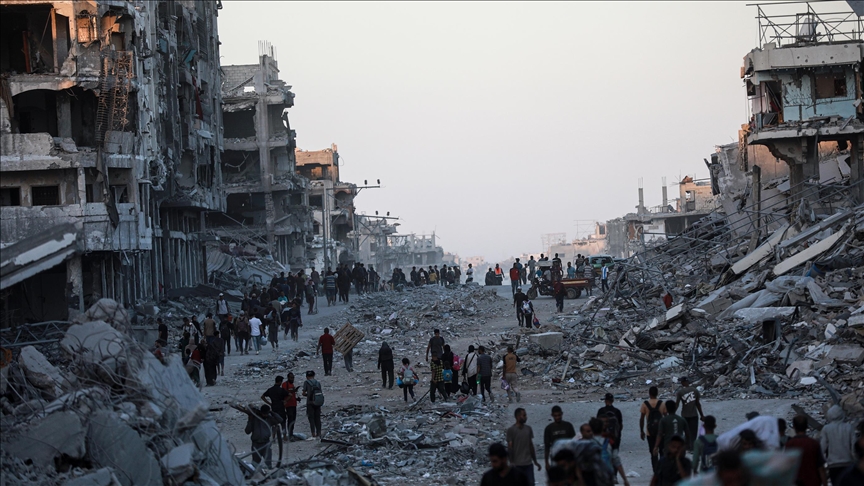
- Challenges on path to recovery include unexploded ordnance, reconstruction cost, prohibition of construction materials, adviser to UN on Gaza’s reconstruction tells Anadolu
- Urgent needs for Palestinians should include immediate shelter, potable water, food, health facilities, experts say
- ‘Challenges to rebuild Gaza will be enormous, will require Israel to commit to allowing rapid repair of infrastructure, road and entry of construction equipment and materials," Norwegian Refugee Council’s Ahmed Bayram tells Anadolu
ISTANBUL
Two years into Israel's genocide in the Gaza Strip, the Palestinian enclave is physically destroyed, socially fractured and economically collapsed.
With more than half of its population displaced, entire neighborhoods flattened and key institutions in ruin, Gaza faces a recovery that experts warn could take decades, and cost billions of dollars.
A comprehensive Gaza and West Bank Interim Rapid Damage and Needs Assessment (IRDNA) report, released by the World Bank, EU and the UN in February, paints a grim picture, with estimated costs of $53 billion, with short-term needs in the first three years to be around $20 billion.
According to the assessment, evaluating the situation from October 2023 to January 2025, the estimated physical damages incurred are around $29.9 billion, and economic and social losses amounting to $19.1 billion.
Other estimates place the cost of reconstructing the enclave even higher than figures cited in the IRDNA report.
The Gaza Media Office put initial losses in vital sectors at more than $70 billion, in a statement Friday, demanding an urgent plan to rebuild.
Ahmed Bayram, media and communications adviser for the Norwegian Refugee Council (NRC), said that rebuilding Gaza will require a global drive, perhaps not seen in decades.
"The challenges to rebuild Gaza will be enormous and will require Israel to commit to allowing the rapid repair of the infrastructure and roads and the entry of construction equipment and materials," Bayram said.
Mamoun Besaiso, an adviser to the UN on Gaza’s reconstruction, stressed the urgent needs of Palestinians living in Gaza.
"The main immediate things to provide to people is shelter. Then we need to establish basic services, especially water. We need to bring food to them, and we need to provide medical services and back-to-school education," said Besaiso.
Bayram agreed. "For now, the focus must be on reversing the deadly famine and providing temporary shelter for people to stay in ahead of winter. Today, the focus must be on preserving human life in Gaza."
Housing: Most devastated sector
Housing remains the most severely affected sector in Gaza, according to several reports.
The IRDNA said that $15.2 billion, or 30% of the total cost, has been earmarked for rebuilding homes, with housing accounting for the largest share of recovery needs.
In the short term, three years, needs are estimated at around $3.7 billion, with a priority to provide shelter and housing options while preparing for housing recovery.
In the medium to long term, the largest needs are related to the reconstruction of destroyed houses at $11.4 billion, the report said.
Israel's war on Gaza has affected the housing sector the most, incurring $15.8 billion, or 53% of damages.
UN spokesman Stephane Dujarric said the Office for the Coordination of Humanitarian Affairs (OCHA) indicated that about 81,000 housing units have been damaged since October 2023.
The UN agency for Palestinian refugees (UNRWA) said in May that Israel has destroyed 92% of Palestinian homes in the enclave.
Health system at near collapse
Reconstruction of the health sector in Gaza will cost more than $7 billion, according to WHO estimates, covering humanitarian response, early recovery and long-term rebuilding.
The UN health agency said the Israeli army carried out 778 attacks on health facilities, damaging 34 hospitals, 91 medical centers and 210 ambulances.
As a result, more than half of Gaza’s 228 hospitals and primary health care centers went out of service, said OCHA.
About one-third of Gaza’s 176 primary health care centers are partially functional, with more than 1,700 health workers killed since October 2023.
Education: Generation lost
Recovery needs for education are said to require an estimated $3.8 billion over five years, said IRDNA.
It said: "Short-term needs are estimated at around US$2.6 billion and would focus on setting up temporary learning facilities including tents and prefabricated buildings, reclaiming education facilities that have been repurposed as shelters for IDPs (internally displaced people) when possible, providing psychosocial support, and addressing severe learning losses."
"Medium-to long-term recovery strategies amount to US$1.2 billion and focus on rebuilding destroyed facilities, enhancing digital infrastructure, and strengthening the sector’s resilience," IRDNA said.
According to UNESCO, as of July 2025, 97% of schools sustained some level of damage to their buildings, with 518 out of 564 either needing full reconstruction or major rehabilitation to be functional.
UN figures show that 17,237 students, 1,271 university students and 967 educational staff have been killed since the beginning of the onslaught in late 2023, with nearly 660,000 children remaining out of school.
Energy sector: Gaza in dark
IRDNA estimates that short-term needs for the energy sector are at $365 million, by securing at least 322,000 liters of fuel daily for diesel generators to meet urgent humanitarian needs in health care, water and food production.
"Medium- to long-term needs are estimated to be US$1.1 billion, focusing on resuming all IEC feeder (International Electrotechnical Commission) lines to supply 120 MW, enabling the GPP with around 400,000 liters of fuel daily to produce 70 MW, installing over 67 MW of solar PV (photovoltaic) with a battery energy storage system, and exploring renewed energy imports from Egypt,” it said.
Reports suggest that Gaza’s energy sector was already constrained due to the limited electricity imports and local generation to less than 35% of demand, creating widespread shortages and frequent blackouts.
Water, sanitation, hygiene: $2.7 billion crisis
Since Oct 7, 2023, Israel has destroyed Gaza's water facilities, desalination units and sewage systems.
The restoration of the Water Sanitation and Hygiene (WASH) sector needs in Gaza amounts to $2.7 billion, said IRDNA.
"Immediate and short-term needs amount to US$664 million, which includes the reestablishment of basic water and sanitation services, emergency repairs, provision of alternative water sources through trucking and bottled water supplies, and access to hygiene supplies."
The remaining $2 billion would focus on strategies to prioritize building resilient water and sewage networks, expand desalination and reuse systems to bolster local water supplies.
A report by UN experts in July said 89% of Gaza's water and sanitation infrastructure has been damaged or destroyed by Israel’s forces, leaving over 90% of households’ water insecure.
Cultural heritage: Silent casualty
Israel's war has also destroyed Gaza's cultural and heritage sector, with approximately 53% of heritage sites damaged or destroyed, resulting in a total estimate of $120 million in damages, IRDNA said.
Notable losses include 27% of cultural assets severely damaged or destroyed, encompassing archaeological sites and significant historic buildings, it said.
The assessment indicated that immediate and short-term needs for 1.5 years amount to $48 million and focus on protecting damaged heritage sites, and long-term efforts amount to $144 million for extensive conservation, rehabilitation and reconstruction.
Challenges, obstacles
Regarding challenges on Gaza's path to rebuilding and reconstruction, Besaiso said one major issue is unexploded ordnance.
"Now 30% of these bombs are not exploded. This is very dangerous," he said.
Another issue is the presence of dead bodies under the rubble, said Besaiso, stressing that even after the ceasefire, Israel struck a building with 60 people trapped under the rubble.
The entry of raw material, construction material and heavy equipment is another obstacle, with Israel having full control of Gaza's reconstruction.
"We are not allowed to bring one bag of cement inside Gaza unless Israel approves. That's why the reconstruction becomes too long and lengthy," said Besaiso.
Citing a UN report last year, Besaiso said if Israel continues to control equipment, it would take 14 years to remove the rubble and 80 years to construct houses.
"We want all construction material to go into Gaza 24/7 nonstop and to allow heavy equipment such as cranes, bulldozers."
Who will rebuild Gaza?
Experts expressed concern about the funds needed for reconstruction.
Besaiso highlighted that several donors are hesitant, fearing repeated cycles of destruction.
"International agencies have agreed to help but have conditions that they will not invest in Gaza until and unless there is a sustainable political solution for Gaza."
Besaiso, who was in charge of Gaza construction during the 2008-2009 war, in which Israel destroyed several establishments, said the EU provided funds to reconstruct. But two years later, Israel destroyed many houses and the EU refused to help.
He highlighted that last year there was a discussion among donors that all money would go to the World Bank trust fund, however, the EU has refused to send funds to the World Bank and is managing its own funds.
He said that while an issue is who will be in charge of the funds, Egypt has suggested the option to have an interim arrangement for managing Gaza reconstruction, terming it a Community Coordination Committee -- a team of experts and technocrats.
Besaiso stressed that to have a full-scale reconstruction and recovery, Israel should withdraw completely from the Gaza Strip, citing examples that constructing water pipes or sewage pipes will not happen because Israel controls the land.
"If Israel continues to occupy 53% of the Gaza Strip, we cannot make full reconstruction," he said.



